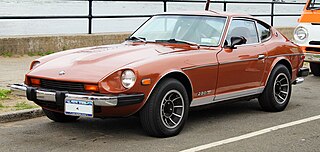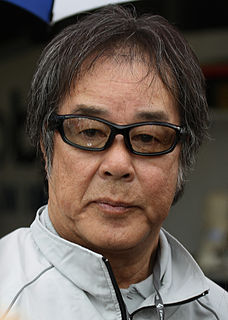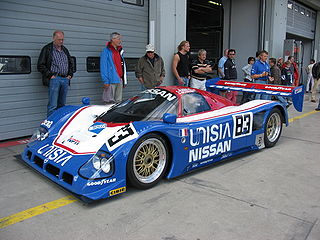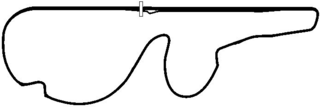
The Nissan Z-series is a model series of sports cars manufactured by Nissan in seven generations since 1969.

Nissan Motorsports International, abbreviated as Nismo, is a division of Nissan Motorsports & Customizing focused in motorsport and performance-oriented car models for Nissan. Nismo was initially a company, Nissan Motorsports International Co., Ltd., formed in 1984 as a result of a merger of two motorsport departments, being the in-house tuning, motorsports and performance subsidiary of Nissan. It has competed in JSPC, JTCC, the 24 Hours of Le Mans and the 24 Hours of Daytona. They currently participate in Super GT, GT Racing and Formula E. Nismo ceased to be a company in April 2022 by being merged with sister Autech into a new Nissan subsidiary, Nissan Motorsport & Customizing.

Kazuyoshi Hoshino is a Japanese former racing driver and businessman.

The Nissan S20 engine 2.0 L (1,989 cc) was a straight-6, DOHC internal combustion engine produced by Nissan from 1969 to 1973, originally designed by engineers of the former Prince. It was essentially a revised production variant of the 1966 Prince GR8 engine from Prince/Nissan's R380 racecar. It produces 160 hp at 7000 rpm and 177 N⋅m; 130 lbf⋅ft (18 kg⋅m) of torque at 5600 rpm. The S20 weighs 199 kg (439 lb). This engine is not to be confused with the unrelated Nissan SR20, which is a straight 4 cylinder petrol engine used in other Nissan models.

Satoshi Motoyama is a Japanese professional racing driver and team manager. He is best known for racing in the Super GT Series, formerly known as the All-Japan Grand Touring Car Championship (JGTC) as a factory driver for Nissan, and for racing in the Formula Nippon Championship. He is a three-time champion of the GT500 class of Super GT, and a four-time Formula Nippon/Super Formula champion, making him one of the most successful Japanese racing drivers of all-time.

The Nissan R391 is a prototype racing car built by Nissan and their motorsports counterpart Nismo for competition at the 1999 24 Hours of Le Mans. It was a replacement for the R390 GT1, which was no longer legal in its production-based class.

The Nissan R90C was a platform used for Group C racing cars built in 1990 by Nissan Motors for competition in World Sportscar Championship (WSC) based in Europe and the All Japan Sports Prototype Championship (JSPC). The cars based on the basic R90C platform would compete until 1993 before Nissan chose to withdraw from sports car racing, not returning until 1997. It won three JSPC championships and several significant endurance races during its career.

The Toyota 7 was a series of racing cars developed by Toyota Motor Company in cooperation with Yamaha Motor Corporation. Designed primarily for use in FIA Group 7 competition, it was Toyota's first purpose-built racing car project.
George Fury is a retired Australian rally and racing car driver. For the majority of his career Fury was associated with Nissan, twice winning the Australian Rally Championship, and twice runner up in the Australian Touring Car Championship. Fury, a farmer living and working in the New South Wales country town of Talmalmo, was nicknamed "Farmer George" or "The Talmalmo Farmer".

The Nissan R88C is a sports prototype race car developed by Nissan and Lola for the 24 Hours of Le Mans.

The JAF Grand Prix All Japan Fuji 1000 km, was the second round of both the 1989 All Japan Sports Prototype Championship and the 1989 Fuji Long Distance Series was held at the Fuji International Speedway, on the 30 April, in front of a crowd of approximately 58,000.
The Dome RC83 was a Group C sports racing car built by Dome in 1983. A replacement for the RC82, which had been unsuccessful in its two 1982 entries, the car featured a 4-litre Cosworth DFL V8 engine and was developed in-house, unlike the RC82, which had a March Engineering chassis. One car was built. The car was replaced by the Dome 84C partway through the 1984 season, although the two cars did overlap during that year.

The CLM P1/01, renamed ENSO CLM P1/01 in 2017, is a sports prototype racing car built for the Austrian and Romanian based team ByKolles Racing. It is designed to meet the 2014 LMP1-L regulations for Le Mans Prototypes in the FIA World Endurance Championship as well as at the 24 Hours of Le Mans. The P1/01 debuted at the 2014 6 Hours of Circuit of the Americas, round four of the FIA World Endurance Championship.

The March 86G was a Group C and IMSA GTP sports racing car built by March Engineering. Built as simply a chassis with no engine, it was branded as one of three cars, the BMW GTP, the Buick Hawk or the Nissan R86V depending on which engine was placed in the chassis and which team was running it. There were a number of subtle bodywork changes to reflect the manufacturer which ran the car.

The 2018 Autobacs Super GT Series was the twenty-sixth season of the Japan Automobile Federation Super GT Championship including the All Japan Grand Touring Car Championship (JGTC) era and the fourteenth season the series has competed under the Super GT name. It was the thirty-sixth overall season of a national JAF sportscar championship dating back to the All Japan Sports Prototype Championship. The season began on April 8 and ended on November 11, after 8 races.
The 2022 Super GT Series was a motor racing championship based in Japan for grand touring cars, sanctioned by the Japan Automobile Federation (JAF) and run by the GT Association (GTA). It was the thirtieth season of the JAF Super GT Championship which includes the All Japan Grand Touring Car Championship era, and the eighteenth season under the Super GT name. It was also the fortieth overall season of a national JAF sportscar championship dating back to the All Japan Endurance/Sports Prototype Championship.

The Toyota 87C, also known as the TOM'S 87C, was a Group C prototype sports car, designed, developed and built by Toyota, for use in sports car racing, specifcally the World Sportscar Championship, between 1987 and 1988.
The Nissan Skyline Turbo C is a Group C prototype sports car based on the R30 Skyline developed by Garage Le Mans for the 1983 All Japan Endurance Championship and Fuji Long Distance Series. There is. It is based on the Skyline Turbo Gr. The engine is equipped with Nissan's LZ20B type.
The Nissan LM04C is a Group C race car developed by Le Mans Garage for the 1984 All Japan Endurance Championship and Fuji Long Distance Series.
The Nissan LM05C is a Group C race car developed by Le Mans Garage for the 1985 All Japan Endurance Championship.













